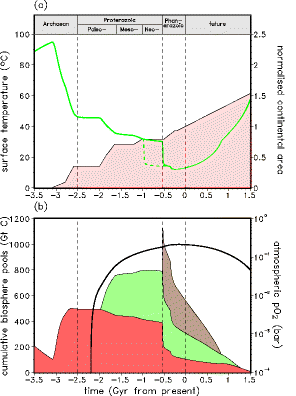 |
||||
| Werner von Bloh
|
|||||
| Cambrian explosion triggered by geosphere-biosphere feedbacks |
|
||||
Werner von Bloh, Christine Bounama, and Siegfried Franck Potsdam Institute for Climate Impact Research (PIK), Telegrafenberg, P.O. Box 60 12 03, 14412 Potsdam, Germany.
A new hypothesis for the cause of the Cambrian explosion is presented. For that the evolution of the planet Earth is described by the co-evolution of the geosphere-biosphere system. Here we specify our previously published Earth system model for the long-term carbon cycle by introducing three different types of biosphere: procaryotes, eucaryotes, and complex multicellular life. They are characterized by different global temperature tolerance windows. The biotic enhancement of silicate weathering by complex multicellular life adds an additional feedback to the system and triggers the Cambrian explosion. The Cambrian explosion is characterized by a sudden increase of biomass and a rapid cooling, which amplified the spread of complex multicellular life. Cooling events in the Neoproterozoic, however, could force a premature appearance of complex multicellular life.
Figure: (a) Evolution of global surface temperature (solid green line). The green dashed line denotes a second possible evolutionary path triggered by a temperature perturbation in the Neoproterozoic era. The colored area indicates the evolution of the normalized continental area according to Condie [1990]. (b) Evolution of the cumulative biosphere pools for procaryotes (red), eucaryotes (green), and complex multicellular life (brown). The solid black curve denotes the evolution of atmospheric pO2. |
|||||
|
|
|||||
| Impressum © PIK 2006 |
